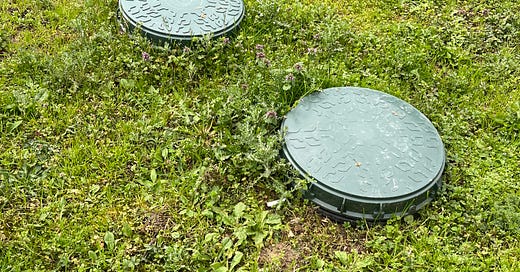From the kitchen window I saw the two vehicles pull into the drive one after the other at the pre-agreed upon time. One a pick-up truck, beloved of farmers, and the other a classic white van, but a new one, with reflective stripes on for better visibility - almost certainly an indicator of some kind of workman or officaldom. They got out to exchange pleasantries whilst I hurried to put on my shoes and come round the corner to do the same.
As I arrived I was already on the back foot and it wasn’t even a language issue: they both had clipboards. Serious times.
Like most french houses in rural areas we do not have mains sewage but a fosse septique. Ours is relatively new as these things go (about 6 years old), but not, bien sûr, conforming to code. It also has the major disadvantage of only being connected to our house and gîte 1, whereas we need something also connected to gîte 2, and that will cover us for the future for gîte 3, when we eventually get round to renovating that.
Guillaume came round a few weeks ago to give us a quote and some advice.
We were informed that we couldn’t just upgrade the exisiting system; a new one was required in order to cater for the potential number of guests (up to 10) plus anyone that may be staying in our house at any given time.
A classic fosse septique was ruled out, because to conform it would need to have a prohibitively large sand filter system attached (50m2 or more). The next cab off the metaphorical sewage treatment rank was a microstation - a more modern solution than an old fosse, but alas for us, one that needs to have consistent usage year round to work effectively.
In using a microstation, we’d have to buy a system large enough to cope with our guests in summer, but we’d not produce enough volume in the guestless periods to ensure correct operation.
Luckily a third solution was available, le filtre compact - essentially a classic-type fosse but with an integral, and much smaller filter attached.
With the emplacement, method and price agreed with Guillaume, a key step in the process is the role of the official sewage inspector.
They come from SPANC. Or as it is properly known, le Service Public d’Assainissement Non Collectif. They approve works for and certify the compliance of new or repaired septic tanks.
In considering the stereotypical local sewage regulator I was expecting a grizzled man in late middle age. He’d be bearded and inscrutable, communicating in gruff undertones, local dialect and/or an impenetrable southern French accent. That, coupled with the inevitable technical vocabulary was sure to leave me up a certain creek with a distinct lack of means of boat propulsion in any conversation.
As it turns out, I was right. But only about the beard and his inscrutability.
The SPANC man was Lucas, and despite him having a name he will forever be known to me as the SPANC man. He was almost certainly younger than I am (so early middle age at best - and I’ll have no chuckling at the back). Although it’s possible that Guillaume had given him prior warning about my simpleton French and he adjusted accordingly, he spoke remarkably comprehensible French.
With introductions complete, it was down to business straightaway. Guillaume explained the role of the SPANC man in approving his plans prior to work commencing, and inspecting them upon completion. Which gave me the opportunity, with a twinkle in my eye, to respond to Guillaume that we better hope he’d got it right then.
A similarly twinkle-eyed response came back from him expressing the utmost confidence in his chosen solution. I suppose with a clipboard accessory, who wouldn’t be confident?
This exchange was the starting gun for Guillaume to start explaining our collective needs, and rhapsodising about his proposals. The tank would be placed over there and a trench dug here (cue pointing), and then over there a further trench for the treated water to drain away (further gesticulation and accompanying sound effects signifying something moving quickly in a straight line).
We walked about the grounds noting key access points for the digger, and the major works. Clipboards were consulted, teeth sucked and pens tapped. SPANC man kept his counsel for the most part, with only the occasional testing of the water with a technical question for Guillaume.
We ended up halfway down the meadow at the proposed water exit point discussing the potential need for an additional coarse filter in that specific tuyau, by which point I had zoned out - pipe chat not being something that gets my juices flowing.
I was snapped back to reality with the understanding that everything appeared to be in order and I now needed to faire la paperasse. The purposed of the second of the day’s clipboards hoved into view rapidly; the inevitable official paperwork needed to be completed.
Headline details of the work were filled in by SPANC man, and then I followed with my personal details allowing all important official SPANC bill to be sent.
And with that he was off - no doubt to his next assainissement assignment.
Guillaume, basking in the glory of another bureaucratic hurdle jumped, told me that he’d call again towards the end of March with a view to starting in early April when the ground was drier.
Big job number one is all systems go.





You got to have them the price for living in the country ! Looking good to go !
Sounds like a big job!! Expensive☹️